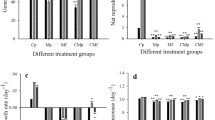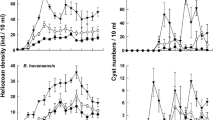Abstract
The combined effect of temperature, food level and the presence of an invertebrate predator on the body size of the rotifer Brachionus havanaensis were tested in this study. B. havanaensis was cultured at 15, 20, and 25°C under three different Chlorella vulgaris levels (0.5 × 106, 1.0 × 106 and 2.0 × 106 cells ml−1) in the presence and in the absence of Asplanchna girodi. For each treatment we maintained three replicates and constant (0.4 ind ml−1) population density of B. havanaensis. In treatments containing A. girodi, the predator was separated from the prey by a mesh (pore size 50 μm). On the last day of the experiment, a portion of the B. havanaensis population was sampled for several morphometric measurements (adult lorica length, width, posterior spine length, body volume, and the egg volume). Size measurements were done by drawing the specimens using a calibrated camera lucida. Statistically significant impact of temperature as well as the predator’s presence was observed on the lorica length, posterior spine, and egg volume of B. havanaensis. The interactions of food × temperature, or predator´s presence × food × temperature were non-significant (P > 0.05) for lorica length, spine length, body volume, and egg volume. Regardless of the type of treatment, there was a direct positive correlation between lorica length and width. Egg volume was linearly related to the adult size. Notably long posterior spines were observed in treatments containing the presence of A. girodi.



Similar content being viewed by others
References
Barry, M. J., 2000. Effects of endosulfan on Chaoborus-induced life history shifts and morphological defenses in Daphnia pulex. Journal of Plankton Research 22: 1705–1718.
Bogdan, K. G. & J. J. Gilbert, 1982. The effects of posterolateral spine length and body length on feeding rates in the rotifer Brachionus calyciflorus. Hydrobiologia 89: 263–268.
Borowitzka, M. A. & L. J. Borowitzka, 1988. Micro-algal Biotechnology. Cambridge University Press, London.
De Ridder, M., 1981. Some considerations on the geographical distribution of rotifers. Hydrobiologia 85: 209–225.
Garza-Mouriño, G., M. Silva-Briano, S. Nandini, S. S. S. Sarma & M. E. Castellanos-Páez, 2005. Morphological and morphometrical variations of selected species of Brachionidae: a seasonal study from Lake Xochimilco (Mexico). Hydrobiologia 546: 169–179.
Gilbert, J. J., 1998. Kairomone-induced morphological defenses in rotifers. In Tollrian, R. & C. D. Harvell (eds), The Ecology and Evolution of Inducible Defenses. Princeton University Press, Princeton, 127–141.
Halbach, U. & G. Halbach-Keup, 1974. Quantitative beziehungen zwischen phytoplankton und der Populationsdynamik des rotators Brachionus calyciflorus Pallas. Befunde aus Laboratoriumsexperimenten und Freilanduntersuchungen. Archiv für Hydrobiologie 73: 273–309.
Hansen, B., T. Wernberg-Møller & L. Wittrup, 1997. Particle grazing efficiency and specific growth efficiency of the rotifer Brachionus plicatilis (Müller). Journal of Experimental Marine Biology and Ecology 215: 217–233.
Lass, S. & P. Spaak, 2003. Chemically induced anti-predator defences in plankton: a review. Hydrobiologia 491: 221–239.
Nandini, S., R. Pérez-Chávez & S. S. S. Sarma, 2003. The effect of prey morphology on the feeding behaviour and population growth of the predatory rotifer Asplanchna sieboldi: a case study using five species of Brachionus (Rotifera). Freshwater Biology 48: 2131–2140.
Nandini, S., P. Ramírez-García & S. S. S. Sarma, 2005. Seasonal variations in the species diversity of planktonic rotifers in Lake Xochimilco, Mexico. Journal of Freshwater Ecology 20: 287–294.
Nandini, S., S. S. S. Sarma, Rómulo Javier Amador-López & Sandra Bolaños-Muñoz, 2007. Population growth and body size in five rotifer species in response to variable food concentration. Journal of Freshwater Ecology 22: 1–10.
Pourriot, R., 1974. Predator-prey relationships in rotifers: effect of the predator (Asplanchna brightwelli) on the morphology of the prey (Brachionus bidentata). Annals of Hydrobiologie 5: 43–55.
Ruttner-Kolisko, A., 1974. Plankton rotifers. Biology and taxonomy. Die Binnengewässer (supplement) 26: 1–146.
Ruttner-Kolisko, A., 1977. Suggestions of biomass calculation of plankton rotifers. Archiv für Hydrobiologie Beihaft 8: 71–76.
Sanoamuang, L.-O., 1993. The effect of temperature on morphology, life history and growth rate of Filinia terminalis (Plate) and Filinia cf. pejleri Hutchinson in culture. Freshwater Biology 30: 257–267.
Sarma, S. S. S., 1989. Effect of Chlorella density and temperature on somatic growth and age at maturity of the rotifer Brachionus patulus (Müller) (Rotifera). Current Science 58: 788–791.
Sarma, S. S. S. & T. R. Rao, 1987. Effect of food level on body size and egg size in a growing population of the rotifer Brachionus patulus Muller. Archiv für Hydrobiologie 111: 245–253.
Sarma, S. S. S. & M. Elías-Gutiérrez, 1999. A survey on the rotifer (Rotifera) fauna of the Yucatán Peninsula (Mexico). Revista de Biología Tropical 47(Suppl. 1): 187–196.
Sokal, R. R. & F. J. Rohlf, 2000. Biometry. W.H. Freeman and Company, San Francisco.
Stearns, S., 1992. The Evolution of Life Histories. Oxford University Press, New York.
Stemberger, R. S., 1990. Food limitation, spination and reproduction in Brachionus calyciflorus. Limnology and Oceanography 85: 33–44.
Stemberger, R. S. & J. J. Gilbert, 1984. Defenses of planktonic rotifers against predators. In Kerfoot W. C. & A. Sih (eds), Predation: Direct and Indirect Impacts on Aquatic Communities. Princeton University Press, USA, 227–239.
Walz, N., S. S. S. Sarma & U. Benker, 1995. Egg size in relation to body size in rotifers: an indication of reproductive strategy? Hydrobiologia 313/314: 165–170.
Weber, C. I., 1993. Methods for Measuring the Acute Toxicity of Effluents and Receiving Waters to Freshwater and Marine Organisms, 4th edn. United States Environmental Protection Agency, Cincinnati, Ohio, EPA/600/4–90/027F.
Acknowledgments
We thank Dr. Ramesh Gulati and two anonymous reviewers for helpful comments on our contribution. E. Lucía Pavón-Meza thanks the Mexican National Council for Science and Technology (CONACyT- 128436) for a scholarship.
Author information
Authors and Affiliations
Corresponding author
Additional information
Guest editors: S. S. S. Sarma, R. D. Gulati, R. L. Wallace, S. Nandini, H. J. Dumont & R. Rico-Martínez.
Advances in Rotifer Research
Rights and permissions
About this article
Cite this article
Pavón-Meza, E.L., Sarma, S.S.S. & Nandini, S. Combined effects of temperature, food (Chlorella vulgaris) concentration and predation (Asplanchna girodi) on the morphology of Brachionus havanaensis (Rotifera). Hydrobiologia 593, 95–101 (2007). https://doi.org/10.1007/s10750-007-9068-3
Published:
Issue Date:
DOI: https://doi.org/10.1007/s10750-007-9068-3




